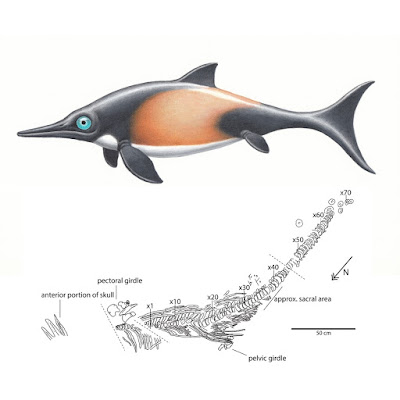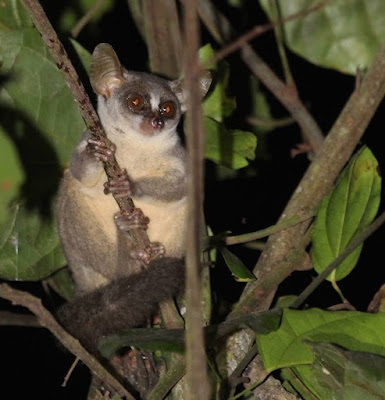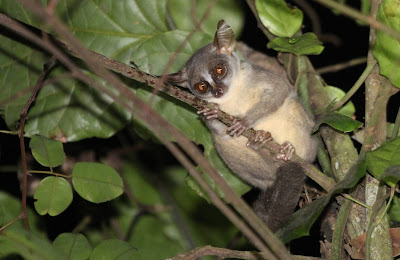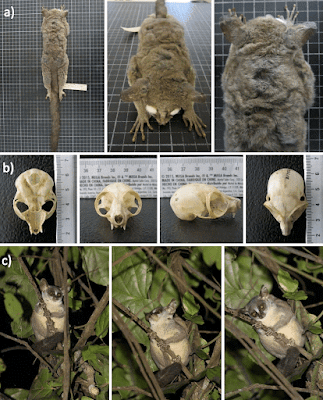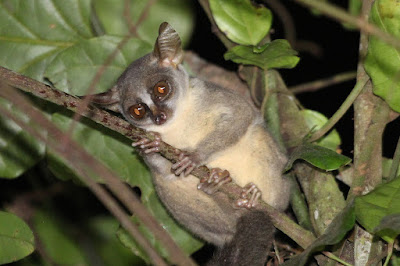![]() |
Nyctibatrachus athirappillyensis, N. manalari, N. pulivijayani, N. radcliffei, N. robinmoorei, N. sabarimalai & N. webilla
Garg, Suyesh, Sukesan & Biju. 2017
|
Abstract
The Night Frog genus Nyctibatrachus (Family Nyctibatrachidae) represents an endemic anuran lineage of the Western Ghats Biodiversity Hotspot, India. Until now, it included 28 recognised species, of which more than half were described recently over the last five years. Our amphibian explorations have further revealed the presence of undescribed species of Nights Frogs in the southern Western Ghats. Based on integrated molecular, morphological and bioacoustic evidence, seven new species are formally described here as Nyctibatrachus athirappillyensis sp. nov., Nyctibatrachus manalari sp. nov., Nyctibatrachus pulivijayani sp. nov., Nyctibatrachus radcliffei sp. nov., Nyctibatrachus robinmoorei sp. nov., Nyctibatrachus sabarimalai sp. nov. and Nyctibatrachus webilla sp. nov., thereby bringing the total number of valid Nyctibatrachus species to 35 and increasing the former diversity estimates by a quarter. Detailed morphological descriptions, comparisons with other members of the genus, natural history notes, and genetic relationships inferred from phylogenetic analyses of a mitochondrial dataset are presented for all the new species. Additionally, characteristics of male advertisement calls are described for four new and three previously known species. Among the new species, six are currently known to be geographically restricted to low and mid elevation regions south of Palghat gap in the states of Kerala and Tamil Nadu, and one is probably endemic to high-elevation mountain streams slightly northward of the gap in Tamil Nadu. Interestingly, four new species are also among the smallest known Indian frogs. Hence, our discovery of several new species, particularly of easily overlooked miniaturized forms, reiterates that the known amphibian diversity of the Western Ghats of India still remains underestimated.
![]()
• Nyctibatrachus athirappillyensis sp. nov.
Athirappilly Night Frog
Holotype. ZSI/WGRC/V/A/891, adult male, from Thavalakuzhipara (10°16′53″N 76°41′25.6″E, 530 m), Vazhachal forest division, Thrissur district, Kerala state, India, collected by SDB and SG on 11 September 2015.
Paratypes. ZSI/WGRC/V/A/892–895, four adult males, and ZSI/WGRC/V/A/896, adult female, collected from the same locality as holotype, by SDB and SG on 11 July 2016.
Etymology. The species epithet is an adjective that refers to Athirappilly falls, which is in close vicinity of the type locality.
Distribution and natural history. Nyctibatrachus athirappillyensis is currently known only from its type locality in the southern Western Ghats state of Kerala. All the specimens were collected from shallow streams or marshy areas covered with thick vegetation or leaf litter. Collection site was located inside a secondary forest. Calling males were found hiding under vegetation either inside the shallow stream or on the edges. Calls were heard and recorded during the late evening between 18:00–22:00 h.
Remark. Biju et al. (2011) erroneously interpreted the “fourth toe disc with dorso-terminal groove, cover rounded distally” in Nyctibatrachus kempholeyensis. In the present study we confirm that the fourth toe disc of N. kempholeyensis has a dorso-terminal groove with cover notched distally.
• Nyctibatrachus manalari sp. nov.
Manalar Night Frog
Holotype. ZSI/WGRC/V/A/897, adult male, from Upper Manalar (09°34′29.31″N 77° 20′10.27″E, 1564 m), Periyar Tiger Reserve, Idukki district, Kerala state, India, collected by SDB and SG on 15 July 2016.
Paratypes. ZSI/WGRC/V/A/898–901, four adult males, collected along with the holotype.
Etymology. The species is named after the type locality Upper Manalar in Periyar Tiger Reserve, from where the type series was collected. The specific name manalari is a noun in the genitive case.
Distribution and natural history. Nyctibatrachus manalari is currently known only from its type locality, which is located south of Palghat gap in the Western Ghats state of Kerala. Animals were found hiding under herbs and grasses growing on or at the edges of a large rocky area inside a primary evergreen forest patch. Calling males were located and recorded at night (between 19:00–21:00 h), but calls were also heard during the day (around 14:00 h). One of the calling males was found next to an egg clutch (eight eggs) deposited under the ground vegetation.
• Nyctibatrachus pulivijayani sp. nov.
Vijayan’s Night Frog
Holotype. ZSI/WGRC/V/A/902, adult male, from Pandipath (08°40′42.0″N 77°11′38.6″E, 1,250 m), Thiruvananthapuram district, Kerala state, India, collected by SDB, SG and Vijayan on 19 June 2016.
Paratypes. ZSI/WGRC/V/A/903–905, three adult males collected along with the holotype, and ZSI/WGRC/V/A/906, adult male, collected from the same locality as holotype, by SDB and SG on 29 June 2015.
Etymology. This species is named after Mr. Vijayan Kani for consistently offering tremendous field support over two decades to SDB and his students during studies in the Western Ghats. Vijayan, a tribal from Agasthyamala hills of Kerala, acquired the name ‘Pulivijayan’ after he braved a leopard’s attack. The name is derived from two words; ‘puli’ meaning leopard in Malayalam (official language of Kerala state) and ‘vijayan’. The species epithet ‘pulivijayani’ is used as a noun in the genitive case. The specific word ‘puli’ also refers to leopard-like spots observed on the dorsal surface of this species.
Distribution and natural history. Nyctibatrachus pulivijayani is currently known only from its type locality, which is located in Agasthyamala Hills, south of Palghat gap in the Western Ghats state of Kerala. Animals were found hiding under herbs and grasses on marshy ground (usually away from water) inside an evergreen forest. Males were observed calling during the day (around 11:00 h) and in the late evening (18:00 h).
• Nyctibatrachus radcliffei sp. nov.
Radcliffe’s Night Frog
Holotype. ZSI/WGRC/V/A/920, adult male, from Thiashola estate (11°13′48.2″N 76° 37′02.1″E, 1920 m), Nilgiris district, Tamil Nadu state, India, collected by SDB and SG on 09 July 2016.
Paratypes. ZSI/WGRC/V/A/921–922, two adult males, collected along with the holotype, and ZSI/WGRC/V/A/923–924, two adult males, collected from the same locality as holotype, by SDB and SG on 08 July 2016.
Etymology. This species is named after the late Major Richard Radcliffe in recognition of his contribution towards biodiversity conservation in the Nilgiris. The species name radcliffei is a noun in the genitive case.
Distribution and natural history.Nyctibatrachus radcliffei sp. nov. is currently known only from its type locality, which is located in the Nilgiris, north of Palghat gap in the southern Western Ghats state of Tamil Nadu. All the specimens were found in crevices under rocks in a hill stream inside the tea estate. In our study, we observed tadpoles of this species during the month of October 2014 and confirmed their identity using DNA. Since calls or breeding activity was not observed at the time of collection (in July), we presume that this species breeds during the early monsoon period. Collections were made between 20:00–23:00 h.
• Nyctibatrachus robinmoorei sp. nov.
Robin Moore’s Night Frog
Holotype. ZSI/WGRC/V/A/925, adult male, from Kakkachi (08°33′02.6″N, 77°23′29.6″E, 1290 m), Tirunelveli district, Tamil Nadu state, India, collected by SDB on 30 August 2002.
Etymology. The species is named for Dr Robin Moore, a wildlife photographer and conservationist, in appreciation of his contribution to amphibian conservation. The species name robinmoorei is considered as a noun in the genitive case.
Distribution and natural history. Nyctibatrachus robinmoorei is currently known only from its type locality, which is located in the Kalakkad Mundanthurai Tiger Reserve, south of Palghat gap in the Western Ghats state of Tamil Nadu. Animals were collected from a marshy area covered with thick ground vegetation, close to a rivulet inside primary forest. Males were heard calling during daytime (12:00–14:00 h) and in the late evening (around 18:00 h).
• Nyctibatrachus sabarimalai sp. nov.
Sabarimala Night Frog
Holotype. ZSI/WGRC/V/A/927, adult male, from Pamba (09°24′17.6″N 77°04′11.6″E, 210 m), Pathanamthitta district, Kerala state, India, collected by SDB and SG on 17 July 2016.
Paratypes. ZSI/WGRC/V/A/928–931, four adult males collected along with the holotype, and ZSI/WGRC/V/A/932, adult female, collected from the same locality as holotype, by SDB, SG, RS, SS on 02 July 2015.
Etymology. The species is named after Sabarimala, a pilgrim site located inside the Periyar Tiger Reserve, from the surroundings of which the type series was collected. The species name is considered as a noun in the genitive case.
Distribution and natural history.Nyctibatrachus sabarimalai is currently known only from its type locality, which is located close to Sabarimala in Periyar Tiger Reserve, south of Palghat gap in the Western Ghats state of Kerala. Individuals were located under leaf litter in a shallow forest stream or under the grasses on wet rocky terrain. A calling male was found positioned next to an egg clutch (10 eggs) deposited inside a slit on a tree stump about one foot above ground. Males were observed calling both during the day (between 15:00–17:00 h) and night (20:00–22:00 h).
• Nyctibatrachus webilla sp. nov.
Kadalar Night Frog
Holotype. ZSI/WGRC/V/A/933, adult male, from Kadalar (10°07′52.0″N 77°00′01.8″E, 1429 m), Idukki district, Kerala state, India, collected by SDB and SG on 08 June 2016.
Paratypes. ZSI/WGRC/V/A/934, adult male, collected along with the holotype, and ZSI/WGRC/V/A/935–936, two adult males, collected from the same locality as holotype, by SDB and SG on 18 August 2013.
Etymology. The species name is derived from the English term ‘web’ between toes and the Malayalam word ‘illa’, meaning ‘no’— referring to the prominently reduced foot webbing in this species in comparison to its close relative Nyctibatrachus deccanensis. The species name is treated as an invariable noun in apposition to the generic name.
Distribution and natural history.Nyctibatrachus webilla is currently known only from its type locality, which is located south of Palghat gap in the Western Ghats state of Kerala. Animals were found hidden either under leaf litter or vegetation on marshy ground close to a shallow rivulet. The specific collection site was located inside a disturbed forest patch adjacent to tea estate. Males were collected and observed calling both during the day (around 10:00–12:00 h) and night (between 19:00–22:00 h).
![]() |
Figure 12: Phylogenetic relationships and distribution of the seven new Nyctibatrachus species described in the study.
(A) Maximum Likelihood phylogram (GTR +G +I; −Ln L = 3621.582) for the 16S mitochondrial DNA dataset of 540 bp representing 35 Nyctibatrachus species (28 previously known +seven new species) from the Western Ghats of India and an outgroup taxa. Bayesian Posterior Probabilities (BPP) and RaxML bootstrap values of >50 are indicated above and below the branches, respectively. (B) Type localities of the new species in the southern Western Ghats of Peninsular India. Distribution points are referenced with species names in Fig. 12A. The Western Ghats biodiversity hotspot region is shaded orange. |
Sonali Garg, Robin Suyesh, Sandeep Sukesan and S.D. Biju. 2017. Seven New Species of Night Frogs (Anura, Nyctibatrachidae) from the Western Ghats Biodiversity Hotspot of India, with Remarkably High Diversity of Diminutive Forms.
PeerJ. 5:e3007. DOI:
10.7717/peerj.3007



















